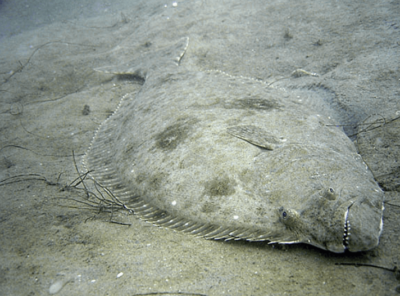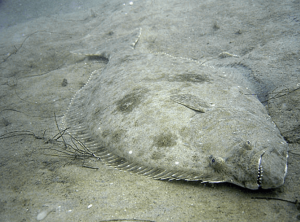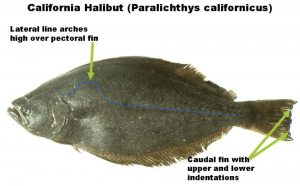
First, they wait, buried up to their eyes… As soon as their prey is within reach…AMBUSHl! TEETH! GOT EM. And guess what? Halibut can chase their food as well, even leaping out of the water to do so.. if it’s their favorite (anchovies)… Who doesn’t love anchovies?!

Paralichthys californicus, the California Halibut, is a large flatfish found in nearshore waters, though they can be found as deep as 600ft. Full grown halibut can get up to 5ft and 72lbs. You may see more of them in shallow waters from February to September because this is when the adults migrate from the continental shelf to spawn. Juveniles spend their days in shallow-water bays and estuaries, making them especially vulnerable to habitat destruction by human activities such as dredging and pollution. Let’s be careful, friends!

Halibut, despite what you may think, are laterally flattened fish, as opposed to dorso-ventrally flattened. One side of their body always faces up, and the other always faces down, with the halibut always swimming on its same side. With both eyes on the top facing side of their body, halibut rely heavily on a visual ambush as a method for feeding. They may be hard to spot due to their ability to change their skin pattern and camouflage with sandy and rocky bottom terrain, but this helps them to ambush their prey by catching them off guard.
 These fish are most abundant from central California to Baja california, and tip the charts as far as “yum” factor. In fact, California halibut is one of the most important commercially-fished species among all state-managed fisheries. To learn more about halibut, like how its eyes migrate to one side of its face, look out for part two!
These fish are most abundant from central California to Baja california, and tip the charts as far as “yum” factor. In fact, California halibut is one of the most important commercially-fished species among all state-managed fisheries. To learn more about halibut, like how its eyes migrate to one side of its face, look out for part two!
SOURCES
comic: http://talesofabsurdity.com/comic/today-in-fish-news/
https://www.montereybayaquarium.org/animal-guide/fishes/california-halibut
https://www.wildlife.ca.gov/Conservation/Marine/NCCFRMP/Halibut-Studies


